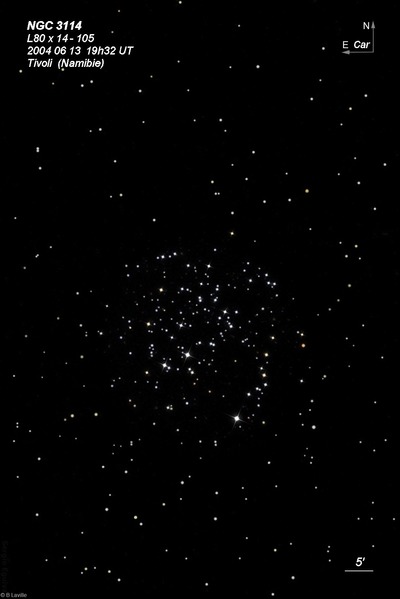
James Dunlop discovered NGC 3114 = D 297 = h3224 on 8 May 1826 with his 9-inch f/12 reflector from Parramatta near Sydney. He described "a beautiful cluster of stars, arranged in curvilinear lines intersecting each other, about 40' diameter, extended S.p., and N.f." This is the brightest object Dunlop discovered and his position is within the cluster, though ~10' NW of center. It's surprising that Lacaille didn't catalogue this bright cluster during his trip to the Cape of Good Hope.
On 4 Feb 1835 (sweep 543), John Herschel noted "an enormous congeries or clustering region of stars 2 or 3 fields in diameter, constituting a decided cluster. Stars 9..14th mag, the larger magnitudes predominating. There must be many hundreds." In his diary, JH noted "the night being most superb - the mirror billiant and the zone swept the richest perhaps in the heavens - attained the sublime of Astronomy - a sort of ne plus ultra".
400/500mm - 18" (7/8/02 - Magellan Observatory, Australia): this very bright naked-eye cluster measures some 35'-40' in diameter and is framed beautifully in a 50' field with the 27mm Panoptic. The cluster contains a couple of long curving chains of brighter stars, one forming a huge "U" shaped arc. There are several pretty smaller groupings and star chains including a striking equilateral triangle of nearly equal mag stars just north of center, consisting of mag 9.2/9.4/10 stars at 20"/22"/27". Two mag 6-7 stars (brightest mag 6.2 HD 87436) are involved and in addition there are numerous 8-9th magnitude stars scattered across the face of the cluster. Appears similar to a bright star cloud in Sagittarius or Cygnus and the cluster is just inferior to NGC 3532. Located 5° west of Eta Carina on the opposite side of Eta from NGC 3532. This is a young cluster (160 million years old) projected onto the Carina complex and the cluster is heavily contaminated by field stars at varying distances.
Naked-eye - and 10x30mm Canon IS (3/28/19 - Tasmania): very bright naked-eye cluster only 5° W of Eta Carinae. At least 3 dozen stars were resolved at only 10x in the 30mm binoculars!
Notes by Steve Gottlieb